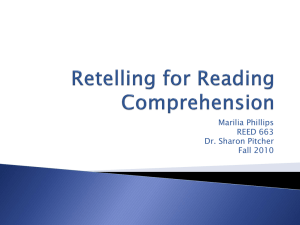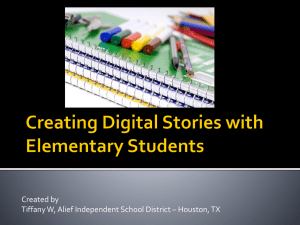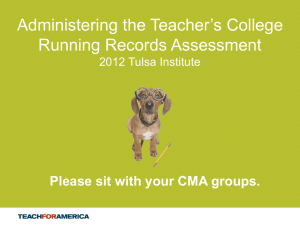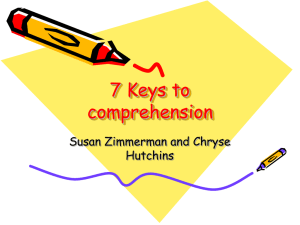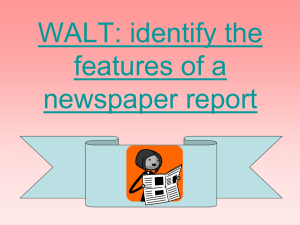Class 6-F14
advertisement
ED LA320 Class 6-F14 Welcome to Class #6 • Please draw a card to determine where you will sit. • • • • • Derivational Suffixes Inflectional Suffixes: Verbs Inflectional Suffixes: Nouns Inflectional Suffixes: Adjectives Analogies: Onset-Rime • Copies of the RICA Review are on the tables for you to begin. Thank you, Ann and Danielle RICA Review • Answer the practice RICA questions. • Submit only if you think you may have answered all correctly. Hitting the “Pause” Button • Running Records • Chapter 2 - Lit Assessment (Word Analysis for beginning/fluent readers) • Cued Retelling • Chapter 3 – Lit Assessment (Comprehension) • Word Analysis Lesson Plan Workshop Time Chapter 3 Reading Guide Cueing Systems - Review • • • • Grapho-Phonic Syntactic Semantic Pragmatic • Note: You may refer to your Cueing Systems Foldable (Class 2 – Septmber 15 – green) LITERACY ASSESSMENT Chapter 2: Reading - Word Analysis [Beginning/Fluent] Running Records Literacy Assessmetn – CH 2 Literacy Assessment – Chapter 2 for Beginning/Fluent Readers • CH 2: Reading – Word Analysis • Running Records are appropriate assessment tools for Early/Beginning and Fluent Readers. • You must complete 1 running record, although, depending on results you might consider doing an addition RR. • Running Records can yield information about which cueing systems a reader uses when he/she reads. • As well, it can be used to determine a child’s independent and instructional reading levels. Functional Reading Levels • Any given text is at one of the following reading levels for any given student. • Independent • Instructional • Frustration • See Resources file on course website • The same text that is at the independent reading level for one student may be at the frustration reading level of another. Why Running Records? • To better understand what readers are doing, which informs subsequent instruction. • Helps us understand what strategies readers are employing and how effective those strategies are. • Focuses on strengths (as well as stretches), doesn’t oversimplify, doesn’t label readers Why Running Records? • RR is an empirical process: • After listening to a reader read, and after discussing what the reader has read, the teacher creates a profile of the reader. • The goal is to consider how a reader uses multiple cueing systems to construct meaning from print text. • What is already known by the reader provides a useful context in which to embed new learning. The 4 Cueing Systems a la RR • Grapho-Phonic Cueing System • In Running Record, this is coded as V (Visual) • Syntactic Cueing System • In Running Record, this is coded as S (Structure) • Semantic Cueing System • In Running Record, this is coded as M (Meaning) RR – only part of the picture • Remember: No one reading assessment or task is sufficient on its own. • The RR is one of the most essential components of a comprehensive assessment of a reader. Running Record – The teacher listens as the student reads aloud marking errors and self-corrections. Suggested Conventions for Recording RR 1. Mark every correct word with a 1. Record a substitution above the text child: home (one error) text: house 1. If a child tries several times to read a word, record all trials child: here / h-- / home (one error) text: house child: h-/ h-text: house / house (no error) Suggested Conventions for Recording RR (cont) 4. If a child succeeds in correcting a previous error this is recorded as a self-correction (SC) child: where / when / SC (no error) text: were 5. If a child deletes a word record with a dash or inserts a word, record the word child: -----(one error) text: house child: here text: ------- (one error) Suggested Conventions for Recording RR (cont) 6. If a child is unable to proceed, s/he is told the word (“T” for teacher) child: home / T (one error) text: house 7. A = Asks for help 7. TTA = Try that again 7. Repetition is not counted as an error, but recorded with a R or R2 or R3 etc.… child: Here is the home / R / SC / (no error) text: Here is the house Sample RR TEXT And how he came to be called Maniac. The town was buzzing. The schools were buzzing. Hallways. Lunchrooms. Running Record toon bussing /SC_ town buzzing We recommend investing $1.99 for the Running Records App – it makes things MUCH easier! Running Record Practice #1 • You are going to practice Running Record. Please know that this process takes time and experience to become proficient. 1. Read the text that the student will read aloud. 2. Listen to the recording a Kindergartner reading the text. 3. Using the marking system, record what you hear as the student reads aloud. 4. With a partner, review you what you recorded. Gabriel RR WITH EMERGENT READER RR Sample #1 Text Look, Dick. Look, Jane. Look and see. See Baby. See, see. Oh, oh, oh. Oh, Dick. Look and see. See Baby. Look, Jane, look. See Baby. Oh, oh, oh. Funny, funny Baby. Information Used E SC MSV MSV _______________________________ Analyzing the RR • Credit the child with any correct words. • There are no penalty for trials which are eventually correct. • Insertions add errors, so that a child can have more errors in a line than words. • If a line or sentence is omitted each word is counted as an error. • Repeated errors (e.g. run is read as ran) count as an error, but substitution of a proper name only counts the first time. What kind of information does the child use? • You will need to look at each error and selfcorrection and ask yourself, “Now, what led the child to say/do that? What cueing system were they using?” • M = meaning. • Did the child use meaning? • S = structure. • Is it syntactically appropriate? • V = visual info. • Is the child using grapho-phonic information? RR Sample Form Revisited Text Look, Dick. Look, Jane. Look and see. See Baby. See, see. Oh, oh, oh. Oh, Dick. Look and see. See Baby. Look, Jane, look. See Baby. Oh, oh, oh. Funny, funny Baby. Information Used E SC MSV MSV _______________________________ Calculations for Error Rate RW = Running Words; E = Errors; SC = Self Corrections Error Rate E RW e.g. 3 = Ratio 1:11 32 Calculations for Accuracy RW = Running Words; E = Errors; SC = Self Corrections Accuracy Rate RW– E = Score Score ÷ RWx100 = accuracy e.g. 32 - 3 = 29 29 ÷ 32 x 100 = .0906 = 91% (1:11) This book is at the child’s instructional reading level. Or, you can use the app… Calculations: • Running Words = 32 • Errors = 3 • Self Corrections = 0 Running Record Practice #2 • You are going to practice Running Record again. Please know that this process takes time and experience to become proficient. 1. Read the text that the student will read aloud. 2. Listen to the recording a 2nd grader reading a text passage from Diary of a Wimpy Kid. 3. Using the marking system, record what you hear as the student reads aloud. 4. With a partner, review you what you recorded. Kai RUNNING RECORD-FLUENT READER Running Record Practice #2 Text Well, I learned my lesson about getting a ride home from Mom, so I’m back to walking to school. But when I was heading home from Rowley this afternoon, I seriously didn’t think I had the energy to make it up the hill to my house. So I asked Rowley if he’d give me a piggyback ride. Rowley didn’t exactly jump at the idea, so I had to remind him that we’re best friends and this is the kind of thing best friends do for each other. He finally caved when I offered… Information Used E SC MSV MSV _______________________________ What kind of information does the child use? • You will need to look at each error and selfcorrection and ask yourself, “Now, what led the child to say/do that? What cueing system were they using?” • M = meaning. • Did the child use meaning? • S = structure. • Is it syntactically appropriate? • V = visual info. • Is the child using grapho-phonic information? Calculations Calculations: • Running Words = 243 • Errors = 4 • Self Corrections = 3 Reading Levels • Any given text is at one of the following reading levels for any given student. • Independent: 95%-100% accuracy • Instructional: 90-94% accuracy • Frustration: Below 90% • Reading level is also dependent on their comprehension, which we will discuss next week. • The same text that is at the independent reading level for one student may be at the frustration reading level for another. RUNNING RECORD-MORE PRACTICE Running Record Practice #3 • You are going to practice Running Record yet again. Yes, this process takes time and experience to become proficient. 1. Read the text that the student will read aloud. 2. Listen to the recording a 5th grader reading a text passage from Maniac Magee. 3. Using the marking system, record what you hear as the student reads aloud. 4. With a partner, review you what you recorded. Running Record Practice #3 Text And how he came to be called Maniac. The town was buzzing. The schools were buzzing. Hallways. Lunchrooms. Streets. Playgrounds. West end. East end. Buzzing about the new kid in town. The stranger kid. Scraggly. Carrying a book. Flap-soled sneakers. The kid who intercepted Brian Denehy’s pass to Hands Down and punted it back longer than Denehy himself ever threw it. The kid who tattooed Giant John McNab’s fastball for half a dozen home runs then cicrcled the sacks on a bunted frog… Information Used E SC MSV MSV _______________________________ What kind of information does the child use? • You will need to look at each error and selfcorrection and ask yourself, “Now, what led the child to say/do that? What cueing system were they using?” • M = meaning. • Did the child use meaning? • S = structure. • Is it syntactically appropriate? • V = visual info. • Is the child using grapho-phonic information? Calculations Calculations: • Running Words = 294 • Errors = 32 • Self Corrections = 5 Reading Levels • Any given text is at one of the following reading levels for any given student. • Independent: 95% - 100% accuracy • Instructional: 90-94% accuracy • Frustration: Below 90% • Reading level is also dependent on their comprehension, which we will discuss next week. • The same text that is at the independent reading level for one student may be at the frustration reading level for another. Basic Procedures for RR • Prepare a text passage for the child to read. • that is representative of what you consider to be “developmentally appropriate.” A good length for 3rd grade and up is 300 words and 150-200 for younger students). • Estimate reading level of text. • You may do this by looking at the back of the book, considering the origin of the text, checking with one of the readability formulas on your computer. • Child should have the text; you have the copy to mark. NOTE: Prepare cued retelling sheet for this text A Word about Fluency See Tompkins [6e] pp. 183-194 • Involves three components: • Accuracy - Word recognition (recognizing words automatically-automaticity) • Pace - Reading rate (the speed at which the student reads) • Expression - Prosody (the ability to read expressively with appropriate phrasing and intonation) • Fluency and reading comprehension are correlated (La Berge & Samuels, 1976; Perfitti, 1985; Stanovich, 1986). Some Characteristics of Students Who Do Not Read Fluently: • • • • • • • • • • Read slowly, word by word and without expression Cannot decode individual words Try to sound out phonetically irregular words Guess at words based on beginning sound Do not remember a word the second or third time in a passage Do not break words into syllables or parts Point to words as they read Repeat words and phrases Ignore punctuation marks Do not remember or understand what they read BREAK Story/Strategy • The story for this class is Loser by Jerry Spinelli. • The strategy is cued retelling. We will also be talking about this strategy as an assessment tool (*You will use this in Chapter 3 of the Literacy Assessment). • This class will provide an introduction to listening and reading comprehension. Cued Retelling • Choose a partner. Determine who is A and who is B. • Person A begins by retelling everything s/he remembers from the story. Person B marks the cued retelling sheet. • Use the cued retelling sheet provided. • B cues A as necessary (see next slide). Cued Retelling • Possible cues: • What can you tell me about…? • What do you remember about…? • What happens when... LITERACY ASSESSMENT Chapter 3: Reading Comprehension Cued Retelling as Assessment Cued retelling allows us to differentiate between what is remembered (memory/recall) and what is understood (comprehension). Cued retelling is also referred to as “aided retelling.” Tompkins (6e), p. 277 Cued Retelling as Assessment • Cued retelling gives the student the opportunity to articulate what s/he remembers and then also to use retrieval cues (bits of information supplied by the teacher or peer) to facilitate further recall. Procedure for Cued Retelling 1. Prepare the cued retelling sheet using the passage/text you selected for this as well as the running record. Identify aspects of the story/text that you consider important and essential to comprehension. • Be sure to think about setting, characters and plot (conflict/actions/resolution). You may want to show this to your cooperating teacher to be sure you have included what s/he considers the key events as well. Procedure for Cued Retelling 2. After the student has read the text, ask him/her to tell you about the story they have just read, as if they were telling it to someone who had never read or seen the story before. • You may want to tape record this so you have it for future reference. Procedure for Cued Retelling 3. As the student is retelling the story, check off each item that s/he mentions. Pay attention to the student's use of detail, sequence of events, story structure, etc. Once the student indicates that s/he is finished, look to see if s/he left out anything on your sheet. If so, then ask the student, "Can you tell me anything about .....?” or “What do you remember about…?” • These are intended to be prompts. Procedure for Cued Retelling 4. Consider this information and what it tells you about this student's reading or listening comprehension. Think about story structure. Does the student include setting, characters and plot (conflict & resolution) in her/his retelling? Does s/he provide details? Was s/he able to describe them after cued? If not, could s/he find the information in the text? USE THE FORM! Cued Retelling- Considerations *See prompts in the Literacy Assessment Chapter 3 description • How many events are freely recalled? • Where did the student start his/her retelling? Does s/he retell events in order? • How does the student respond affectively? • What similarities/differences do you notice between the two retellings? Literacy Assessment • You will do TWO cued retellings. • Emergent Readers: you will choose either a familiar and an unfamiliar text, a narrative and an expository text, or you may also choose to read aloud an illustrated text and and another without illustrations, assessing listening comprehension. If student can read, follow procedures for beginning/fluent readers. • Beginning/fluent readers: you will choose either a familiar and an unfamiliar text, a narrative and an expository text, or an oral and a silent reading of two comparable texts. WA Workshop Time! WA Workshop Time • You are encouraged to sit next to a colleague whom you trust to give you critical and instructive feedback. • You have FB forms that are designed to facilitate your analysis of your colleague’s WA Lesson Plan draft. • You may make margin notes, use post-it notes, edit directly on your lap top… Whatever works for you! • The objective is for you to ask questions and glean insights. Homework Read: • Tompkins Chapter 8: Promoting Comprehension: Reader Factors (pp. 248-287) Do: • HW Reading Guide – Chapter 8 (Website: Class 6 Materials) • Download and bring Cloze information (Website: Literacy Assessment Chap. 3 Reading Comprehension) • Word Analysis Lesson Plan assignment (K-2) due Oct. 20 • Word Analysis Lesson Plan assignment (3-6+ESC) due Oct. 27
